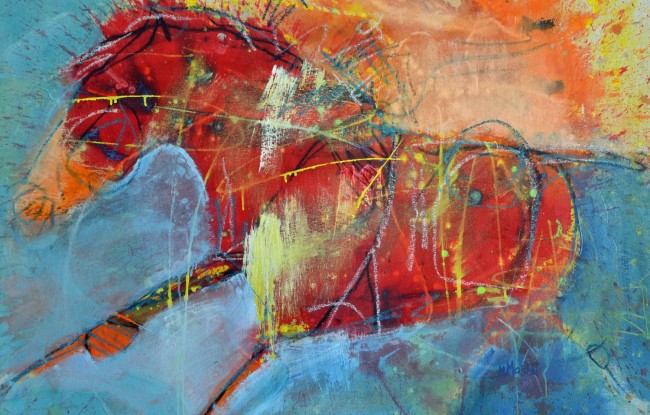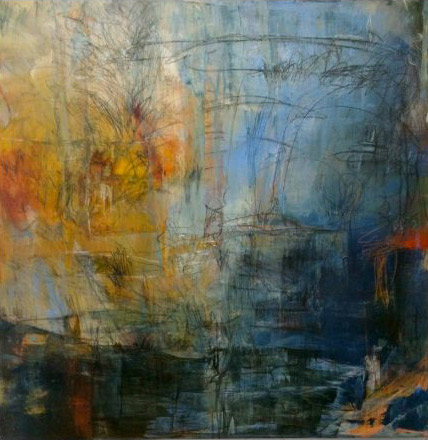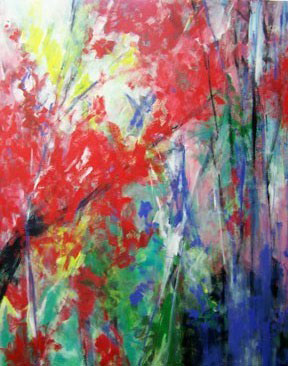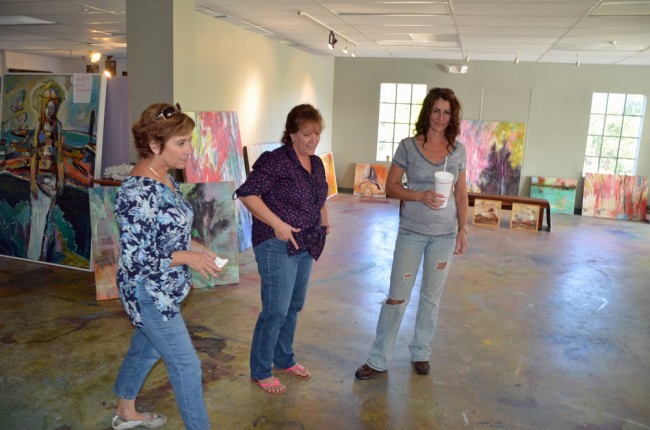
Pat Zalisko is headless this time around.
Almost a year ago, when Zalisko first had a show at the Hollingsworth Gallery, she was into big, bold (and bald), brash heads that got it yours with their stares, their unexpected colors, their blank slates daring you to fill them in. Her work this time is all new. At first she’ll seem like a different artist: more abstract, more restless, and in a couple of cases (described below) more unsettling. It could be her new digs, or the company she’s keeping: for the past year she’s shared a huge studio—a reformed barn, actually—with artists Karlene McConnell and Melissa Mason.
Neo Expressions: The Art of Pat Zalisko, Karlene McConnell and Melissa Mason:
- The exhibit of new work by the three artists, who share a studio in New Smyrna Beach, opens with a free reception Saturday, Dec. 10, from 6 to 9 p.m. and runs through the month at Hollingsworth Gallery, located at City Market Place, 160 Cypress Point Parkway, behind Walmart, in Palm Coast. Call 386/871-9546 for details.
McConnell’s work is calmer, even calming. Her paintings have a thing for trees almost as spiritual creations. She was part of the same exhibit that featured Zalisko’s work at Hollingsworth last February. Mason’s work is all horse power: she paints horses at an impressionistic gallop, she owns horses, she owns a stable, and it’s part of her barn that she turned into a studio about a year ago. The barn is 90 feet long. It had 12 stalls. Mason didn’t need 12 stalls. She ripped everything out, poured concrete, closed out and insulated the interior, and there it was: a 1,000 square foot studio with a big glass wall that looks out over a pasture. “We have lots of room, big walls to paint on,” Mason says. It’s called Neo Studios and Stables, it’s where all three artists now work together, and it gave the new exhibit at Hollingsworth, which opens Saturday with a free reception at 6 p.m., its name: Neo Expressions.
So back to Zalisko’s restlessness.
In October she was in Nashville, studying art. She stumbled on a new method, using unconventional tools for her paintings, including power sanders, wall-paper brushes, brooms. “I love to draw, I love to scribble, and when I’m doing it, I’m coming from a place that’s very—I’m not thinking, it’s not coming from a place that’s cognitive,” Zalisko says. “It’s truly stream of consciousness, it’s whatever’s going through my mind at the moment, and then I’ll wake up and I’ll see that I have a piece that’s really completed.” Pieces like “Twilight,” a square panel of dark blues and greens fading into each other opposite a diminished splash of yellow, and with what looks like elaborate, thin-tipped scribbles superimposed on the colors. “Voice” drips into itself with some of the same processes, in in browns and blues tending to gray. The work is very abstract, but not entirely so.
The starkness of the February exhibit’s head theme, its in-your-facedness, does reappear in other ways. Take “Chornobyl,” painted while Zalisko was thinking of the 25th anniversary of the Chernoyl nuclear disaster in the Ukraine, still the worst nuclear-power disaster in history. (She spells the name of her painting the Ukrainian way, an act of preservation against the Russification of the language: she is herself a Ukrainian by descent.) It fell around the time of the Fukushima Daiichi nuclear disaster in Japan last March. “And I realized how little we’ve learned over the past 25 years,” Zalisko says. The panel is a battle of brusque reds against swaths of whites edging off into blacks, with just a hint of the recognizable symbol for radioactivity, in black, at the lower-center of the painting. Absent an explanation one might take the symbol for a rough sketch scamp of a mouse ready to dart from the darkness visible to the left, and masses of shapes above. Nothing says of course that that’s not an approximation of the way the people hundreds of thousands of people downwind from Chernobyl felt, or ended up being treated, at the time of the disaster: flushed out.
Or take “Don’t Fuck With New York,” a bleak house of a painting dark with shards and spokes: An attorney by training, Zalisko was practicing in New Jersey at the time of the attacks on the Twin Towers in 2011. She lost eight friends that day, and feared having lost her husband, a police officer who’d been dispatched into Manhattan, and with whom she was out of touch for an eternity. He was safe, though she hardly saw him for three months. She remembers going to several funerals during that period. At one funeral, the only remain was a fingernail. She cannot remember those days without crying. And she remembered them in that painting, its name as stark as its rendition.

“My work is still all about nature,” McConnell says, describing what she hopes people will see in it. “I want them to see the enjoyment that I feel and the hope. In fact my Lifeline series was created when we were going through some times in our family, fighting illnesses and difficulties, and actually this large one, ‘Intersections’”—she points to a big work from the Lifelines series, its trees aflame in primary reds and blues in thickets, a Cambrian explosion of life—“was chosen by Hospice to be used at one of the fund-raisers for Hospice. I don’t always do that, but it was something near to my heart over the past year.” It’s engulfing: that’s the feeling McConell wants to create.

(© Karlene McConnell)
But what Mason’s works all have in common is the horse in one shape or another, however silhouetted or suggested. “It used to be I painted the horse for the horse’s sake,” Mason says. Now, it’s “more like a gateway into the practice of painting, with horses as a motif.”
When the three artists were interviewed for this piece, their work was strewn against the gallery’s walls, not yet hung. Graham walked about, talked with the artists, looked at the work, mulling over what he would do with it. The final result wasn’t seen before this piece was written. Nor had the artists seen it, though word spilled out by Thursday, when the work was hung, that the gallery was alive again, itself remade by the work on display. The surprise lifts on Saturday.

Click on the image for larger view. (© FlaglerLive)





























Leave a Reply